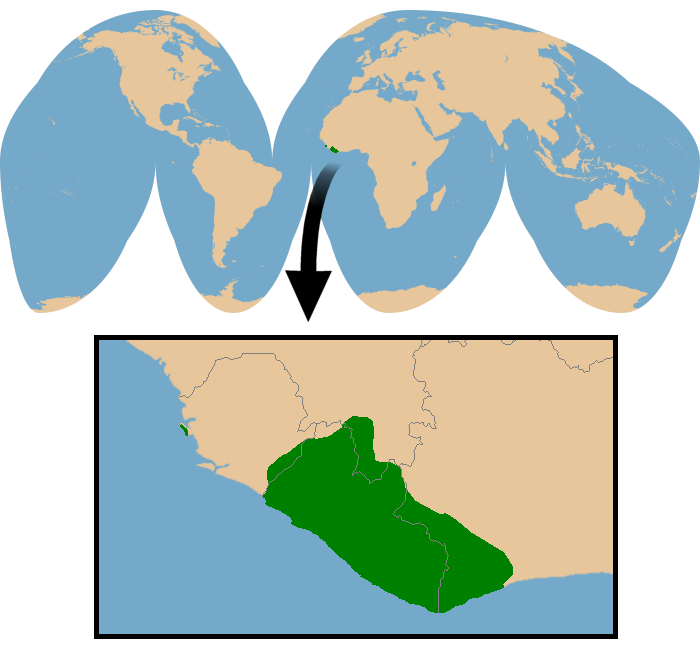Kingdom: |
Animalia Chordata Mammalia Artiodactyla Ruminantia Bovidae Cephalophinae Cephalophus |
Common name:
Scientific name:
Other names: |
Zebra duiker
Cephalophus zebra
Banded duiker, céphalophe zèbre, céphalophe rayé, Zebraducker, Streifenducker, duiquero cebrado, were, nemmeh, mountain deer, marked deer |
Physical Characteristics
- Head and body length:
85-90 cm
- Shoulder height: 40-50 cm
- Tail length: 15 cm
- Adult weight: 15-23 kg
- Shoulder height: 40-50 cm
The zebra duiker's light gold or reddish-brown body is strikingly marked from the shoulders to the rump with 12-16 black (or dark brown) transverse stripes. The striping pattern (number of stripes, degree of tapering, and arrangement) is unique to each individual. The shoulders and lower legs are darker than the rest of the body, and blackish bands encircle the upper legs (both front and rear). The undersides are pale. The tail is rufous and lacks stripes. The face is an overall deep chestnut brown color; there are no distinctive markings, but the muzzle is black and the lower jaw whitish. The horns are short, smooth, sharp cones in both males (4-5 cm) and females (up to 2-3 cm).
- Similar species
- The extinct thylacine or Tasmanian tiger (Thylacinus cynocephalus) is the only recent species with a similar striped coat. In zebra duikers, the stripes from the shoulders to the hips all extend well down the sides, and past the hips they become very narrow and disappear before the tail. In the thylacine, the stripes are aften very short and narrow from the shoulders to the mid-back, and past the hips they remain wide and continue onto the tail.
Reproduction and Development
- Gestation period:
221-229 days.
- Litter size: One.
- Weaning: Around 95 days.
- Sexual maturity: Approximately two years.
- Life span: 11-13 years in captivity.
- Litter size: One.
Ecology and Behavior
The zebra duiker is a diurnal species, but is shy and rarely seen in the wild. The normal social unit appears to be a breeding pair; the pair bond is reinforced with mutual rubbing, licking, and scent-marking. This species is thought to be territorial, and (based on heavy scars in many individuals) appears to fight quite vigorously. Although generally quiet, both sexes my make throaty grunting sounds during courtship.
- Family group:
Breeding pairs or solitary.
- Diet: Mostly fruits and seeds, also leaves and sometimes animal matter.
- Main Predators: Leopard.
- Diet: Mostly fruits and seeds, also leaves and sometimes animal matter.
Habitat and Distribution

Conservation Status
- IUCN Red List:
Vulnerable (2012).
- CITES Listing: Appendix II (2012).
- Threats: Hunting and habitat loss.
- CITES Listing: Appendix II (2012).
The zebra duiker is highly dependent on mature rainforest, and is thus one of the first species to disappear with logging. Recent population estimates suggest that only 15,000 individuals may survive in the wild.






